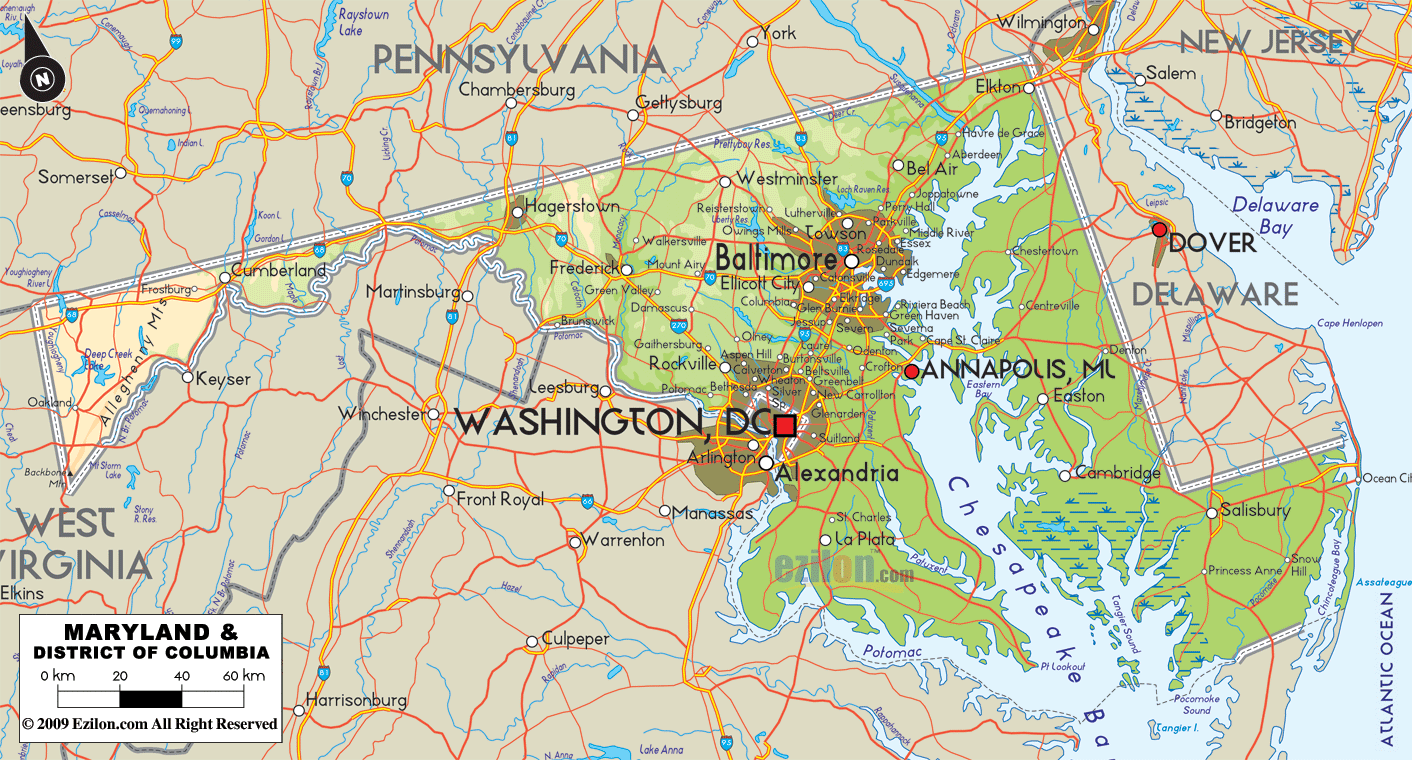

Description: The Physical map of Maryland showing major geographical features such as rivers, lakes, swamps, topography and land formations.
 Maryland, often called the "Old Line State" or "Free State," is a geographical marvel within the United States, characterized by its multifaceted terrain. With its intricate detailing, the physical map of Maryland offers a captivating representation of the state's extensive geographical features, ensuring every viewer gains a profound appreciation of its layout.
Maryland, often called the "Old Line State" or "Free State," is a geographical marvel within the United States, characterized by its multifaceted terrain. With its intricate detailing, the physical map of Maryland offers a captivating representation of the state's extensive geographical features, ensuring every viewer gains a profound appreciation of its layout.
Southern Maryland, a region that encapsulates the essence of the state's maritime legacy, is defined by a series of prominent waterways and unique landscapes. The magnificent Potomac River is one of the most distinguishing features here. Originating from West Virginia, it snakes through Maryland, and as it approaches the state's southern boundary, it widens, marking a natural distinction between Maryland and Virginia. This river has been significant in forming the history and economy of the area.
Adjacent to the Potomac, St. Mary's Peninsula emerges, rich in history with sites like St. Mary's City, Maryland's first colonial settlement. As one progresses inland, the coastal plains gradually morph into the Piedmont plateau, marked by gentle, rolling hills. Numerous creeks, like Zekiah Swamp and Nanjemoy Creek, punctuate this landscape, eventually merging with more significant rivers.
The Catoctin Mountain Range catches your attention as you observe the map due to its undulating hills. An offshoot of the larger Blue Ridge Mountains, Catoctin has shaped the state's geological and cultural landscape. Within its embrace lies the Catoctin Mountain Park, renowned for its ecological significance and the location of Camp David, the U.S. Presidential retreat.
To the west of this mountain range lies the fertile Hagerstown Valley, a testament to the power of limestone erosion. Further east, the majestic Susquehanna River carves its path. With its origins in New York, this ancient river cuts through Pennsylvania before gracing Maryland and ultimately surrendering to the vast Chesapeake Bay. It's not merely a river but an artery that has nourished life and civilizations for millennia.
Often referred to as the Eastern Shore, this part of Maryland is a tapestry of aquatic splendors. Dominating the scene is the iconic Chesapeake Bay, North America's most extensive tidal estuary. The Bay isn't just a water body but a lifeline for Maryland, affecting its climate, economy, and way of life. From its embrace emerge rivers like the Choptank and Nanticoke, each telling tales of times gone by.
The Delmarva Peninsula is a sentinel in the east, characterized by its sandy soil and flat landscapes. While appearing tranquil, this region is a hotspot of biodiversity, especially in areas like the Blackwater National Wildlife Refuge, which safeguards Maryland's precious tidal wetlands.
Here, the map showcases Maryland's rugged side. Sections of the vast Appalachian Mountains blanket the region. Within these are the Allegheny Mountains, home to the state's highest peak, Backbone Mountain, standing tall at 3,360 feet. These elevations are not just topographical features but hold within them rich coal reserves, which have driven the state's economy in the past.
Amidst this mountainous terrain, a blue jewel stands out - the Deep Creek Lake. With over 65 miles of shoreline, it's a haven for water enthusiasts and nature lovers.
Serving as the state's heartbeat, Central Maryland is a blend of natural beauty and urban sprawl. The location lies in the space connecting the Piedmont Plateau and the Atlantic Coastal Plain. The Patapsco River, which meanders through this area, has been instrumental in the region's industrial growth, particularly around Ellicott City.
Maryland's most populous city, Baltimore, graces the central region. Situated right by the Chesapeake Bay, its Inner Harbor, while artificial, is of paramount importance due to its contribution to trade and commerce.
Maryland, situated in the mid-Atlantic, shares its space with several neighbors. To the north lies Pennsylvania, a boundary defined by the Mason-Dixon Line. Delaware stands to the east, while to the south, the Potomac River creates a natural border with Virginia. On the western front, Maryland nestles against West Virginia. These state lines are marked on the map, providing viewers with a comprehensive understanding of Maryland's geographical context.
This physical map of Maryland is more than just a visual tool; it's a journey. Journeying across undulating hills, vast stretches of open plains, dense forests, and expansive bodies of water. It's a testament to Maryland's rich geographical tapestry and its undeniable significance in America's landscape.
In Maryland, the state parks are verdant treasures that dot the geographical tapestry, each providing a unique vantage point to understand and appreciate the region's natural beauty and history. On the map, identifying these state parks can be facilitated by recognizing the intricate interplay of landforms, water bodies, and topographical features surrounding them. Let's navigate through some of Maryland's renowned state parks:
Assateague State Park: This park is south of Ocean City, located on Assateague Island near the eastern coast. On the map, follow the slender barrier island on the east edge of Maryland; the park occupies a section of this island.
Deep Creek Lake State Park: Venturing to Deep Creek Lake in western Maryland will lead you to this park. The lake holds the record for being the largest in the state. The state park occupies a portion of the lake's eastern shore.
Sandy Point State Park: This park is near Annapolis, close to the northwestern shores of the Chesapeake Bay. On the map, trace the contours of the Chesapeake Bay, and as you approach the region just before the Bay Bridge, you will be in the vicinity of Sandy Point.
Patapsco Valley State Park: Stretching 32 miles of the Patapsco River, this park is primarily in Central Maryland. Look for the river snaking through regions near Baltimore and Ellicott City to find it on the map.
Point Lookout State Park: Maryland's western shore culminates at its lowest point in this park—the location where the Potomac River and the Chesapeake Bay merge is there. By charting the course of the Potomac River until it converges with the Bay, you can discover its whereabouts on the map.
Cunningham Falls State Park: The Catoctin Mountains host this park in the northern area of Maryland. You can find it easily on the map because it is close to Thurmont. It stands out because it has high areas and winding landscapes, which are common in this area.
Rocky Gap State Park is in Western Maryland and surrounds the beautiful Rocky Gap Lake. Locate it by finding the lake in the region between Cumberland and the eastern boundaries of Green Ridge State Forest.
Gunpowder Falls State Park: This park is in Maryland and covers an area of over 18,000 acres. This area extends across Harford and Baltimore counties, occupying the central-northeastern region of the state. On the map, identify the sprawling area near the Gunpowder River and the Big Gunpowder Falls.
Tuckahoe State Park: Situated on the Eastern Shore, this park is close to the town of Queen Anne. Locate it by recognizing the central part of Maryland's eastern peninsula, especially by identifying Tuckahoe Creek, which winds through it.
Greenbrier State Park: Boonsboro is near this park, within the Appalachian Mountains. The northwestern section of the map contains it. Look for the mountainous terrains and the large Greenbrier Lake.
These state parks, while only a fraction of Maryland's vast park system, are significant markers on the map. Identifying them involves recognizing key geographical features and understanding the state's general layout. By cross-referencing the broader features like rivers, lakes, and cities with the known locations of these parks, any map reader can pinpoint these natural jewels.

Counties and Road Map of Maryland
Counties and Road map and map image of Maryland.

Regional Directory of Canada
Information and guide about Canada and website listing.

Regional Directory of United States of America
Information and guide about United States of America and websites with American topics.

Regional Directory of Europe
Information and guide about Europe and websites with European topics.

Regional Directory of Australia
Information and guide about Australia and websites with Australian topics.